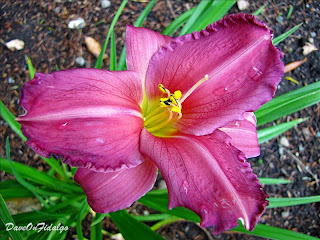Walking the Garden
 |
| Daylily Hemerocallis 'Whimsical' |
This has been a tough spot for gardening. The soil is glacial and depending on the location, can be hardpan, sand or mucky clay. All of it is rocky and dry as dust in the summer. Two plants that seem to do well here are Daylilies and Cranesbill or true Geraniums. I have decided to plant more Daylilies and Cranesbill in the worst problem spots. 'Whimsical' is a new Daylily just planted this year.
 |
| Cranesbill Geranium 'Rozanne' |
 |
| Daylily Hemerocallis 'Stella de Oro' |
 |
| Agastache 'Grape Nectar' |
 |
| Lobelia 'Complement Deep Red' |
 |
| Shasta Daisy "Schneehurken' |
Last year's leaves are now dying on the Madronas. They will be dropping off over the next month or so, but the new leaves will stay on the tree all winter. This tree marks the entrance to the shade garden:
The east end of the shade garden gets morning and midday sun, where a small patio offers a place to sit down. The afternoons are shady here. The best way to watch wildlife is to sit quietly and let it come to you. I have had deer come within yards of me sitting on that bench.
 |
| Oregon Oxalis (O. oregana) |
The bare ground on either side of this path had been carpeted with Oxalis and Sweet Woodruff. Most of the plants in this area are natives, or like the Rhododendrons, relatives of native plants. The Rhododendrons and Red Currant provide a burst of blooming in the spring. This is a green oasis the rest of the year.
Across the driveway from the shade garden is a grove of Rhododendrons growing in the understory of mature Douglas Firs. It's a bit like a secret garden. You can't really tell what's in there from the outside. You must go inside to see what's happening.
Another pleasant discovery is finding native Mahonias and Salal coming up in the grove among the Rhododendrons. Both Salal and Mahonia nervosa grow wild all over this end of the island. The taller Oregon Grape (M. aquifolium) also likes to grow in the sunnier spots.
I am very fond of Japanese Maples (Acer palmatum) and the one in this photo got off to a slow start. I am pleased to find this 'Sango Kaku' or Coral Bark Maple looking so good now. In a shady spot, its yellow-green leaves stand out. In the fall they will turn bright yellow. Once established, Japanese Maples are surprisingly tough and tolerant of poor conditions, even some drought. Just give them a little babying in the beginning and they'll take care of the rest. This one will eventually be 15 to 25 feet tall.
Another surprise was finding leaf lichens growing with the moss in the path between flagstones. The only other place I have seen this lichen is in Deception Pass State Park. Perhaps I brought the spores home with me after a visit.
In the front yard, Lady Ferns (Athyrium filix-femina) come up wild in a stone wall. These are more than waste high this year, probably because of the wet spring we had. Western Sword Ferns (Polystichum munitum) also come up wild among the stones. I have left specific instructions to the yard crew to leave them alone.
Rhododendrons are now setting buds on the new growth for next year's bloom. Can you name the family to which this Rhody belongs? The identifying feature is the powdery indumentum on the new growth. The answer is at the end of the post.
All of the maples in the yard are at their best right now. This one is a native Vine Maple (Acer circinatum). The next is a closeup of the Coral Bark Maple and the last one is the Full Moon Maple (Acer japonicum 'Vitifolium') that I planted last year.
I hope you enjoyed this late summer walk around my garden. Now take a walk around yours. Look closely and see what might have gone unnoticed before.
Were you able to identify the Rhododendron? The species R. yakushimanum from Japan and all of its hybrids have a unique, powdery fuzz on the undersides of their leaves. The new growth also sports this "indumentum" temporarily. If you spot a Rhody with this fuzz, you can bet it's one of the "Yaks."














